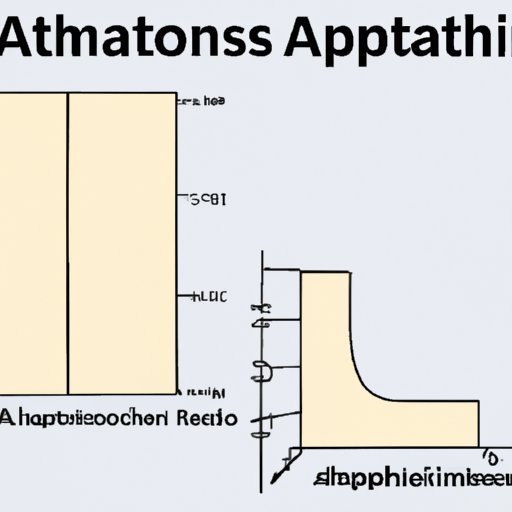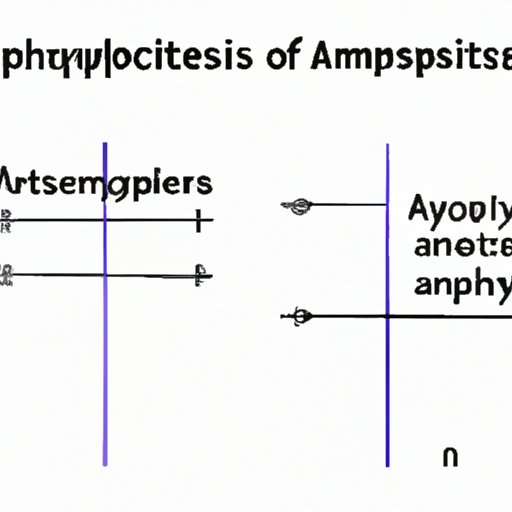
I. Introduction
Asymptotes are important mathematical concepts encountered in algebra and calculus. They are lines that a curve approaches but never touches. Horizontal asymptotes refer to the lines that a curve approaches as the variable becomes infinitely large or small, while vertical asymptotes indicate the values where the curve approaches infinity or negative infinity. Finding these lines can be useful in graphing an equation accurately and understanding the behavior of a function. In this article, we will explore how to find the horizontal and vertical asymptotes using various methods.
II. Mastering the Basics: A Simple Guide to Finding Horizontal and Vertical Asymptotes
To understand how to find asymptotes, it is essential to be familiar with some basic terms. An equation is a mathematical expression that represents a relationship between variables. A limit is the value that a function approaches as its input approaches a certain value.
A. Identification of horizontal asymptotes
The simplest way to determine horizontal asymptotes is to find the highest degree of the numerator and denominator of a rational function (a function with a fraction that contains polynomial equations). If the degrees are equal, the horizontal asymptote is the ratio of the leading coefficients. If the degree of the denominator is greater, the horizontal asymptote is zero. If the degree of the numerator is greater, there is no horizontal asymptote.
B. Identification of vertical asymptotes
To identify vertical asymptotes for a rational function, we need to look at the denominator of the fraction. The vertical asymptotes are the values that make the denominator zero. However, if the numerator is also zero at the same point, it is an undefined or removable discontinuity instead of a vertical asymptote. To find non-removable discontinuities, find the limit as the variable approaches that point from both sides of the graph. If the limits are unequal, the function has a vertical asymptote at that point.
III. Navigating Limits: Tips for Identifying Horizontal and Vertical Asymptotes
A. The concept of limits
To find vertical and horizontal asymptotes using limits, we must understand the concept of limits. A limit is the value that a function approaches as the input variable approaches a certain value. As the input gets closer and closer to the given value, the output of the function may get closer and closer to a particular value, or it may not converge, becoming either infinity or negative infinity.
B. Determining the limit at infinity
To find the limit of a function as the input variable approaches infinity or negative infinity, we can divide every term in the function by the highest power of the variable in the denominator. This will reveal the behavior of the function as it approaches infinity and help us find the horizontal asymptotes.
C. Identifying horizontal asymptotes using limits
If the limit of the function as the input approaches infinity or negative infinity is a finite value, this value is the horizontal asymptote. If the limit does not exist, there is no horizontal asymptote.
D. Identifying vertical asymptotes using limits
If the limit of the function as the input approaches a point where the function is undefined (a point of non-removable vertical discontinuity), the function has a vertical asymptote at that point. If the limit exists, but it is infinity or negative infinity, this value is the vertical asymptote.

IV. Demystifying Asymptotes: Easy Methods for Finding Horizontal and Vertical Lines
A. Rules for horizontal asymptotes
For rational functions, the horizontal asymptote is y = 0 if the degree of the denominator of the fraction is greater than the degree of the numerator. If the degrees are equal, the horizontal asymptote is y = the ratio of the leading coefficients.
B. Finding vertical asymptotes
Vertical asymptotes of a rational function occur where the denominator of the function becomes zero. To find these points, set the denominator equal to zero and solve for the variable. The resulting values where the function is undefined will form vertical asymptotes.
1. Identifying non-removable discontinuities
These occur when the limit of the function as the variable approaches the point from both directions is not the same. To find the vertical asymptotes, set the variable equal to the value of the non-removable discontinuity.
2. Identifying removable discontinuities
These occur when the limit of the function as the variable approaches the point from both directions is the same, but the function is undefined at that point. To find the vertical asymptotes, factor the numerator and the denominator of the function, then cancel out any common factors. The result should be a new function that is identical to the original function except at the point of the removable discontinuity.
C. Practice problems
– Find the horizontal asymptote of the function y = (x^3 + 2x^2 – x – 2) / (x^3 – 3x^2 + 2x).
– Find the vertical asymptotes of the function y = (x^2 – 9) / (x – 3)(x + 2).
V. Cracking the Code: Understanding the Meaning Behind Horizontal and Vertical Asymptotes
A. Real-world application of asymptotes
Asymptotes are useful in real-world applications such as finance, economics, physics, and engineering. For example, economists may use asymptotes to model demand and supply curves, while engineers may use them to design bridges and buildings.
B. Explanation of why asymptotes occur
Asymptotes occur because of the behavior of rational functions as they approach infinity or values that make the denominator zero. These values indicate where the function becomes either infinite or undefined, and the asymptotes provide a way to visualize this behavior.
C. Limitations of asymptotes
Asymptotes provide a simplified way to approximate functions, but they have limitations. They only describe behavior far from the graph’s center, and they cannot provide detailed information about specific points on the graph.
VI. Finding the Limit: Strategies for Pinpointing Horizontal and Vertical Asymptotes
A. Visual representation
One way to find horizontal and vertical asymptotes is to graph the function and look for where the graph approaches lines without touching them.
B. Algebraic methods
Algebraic methods involve analyzing the function to identify its behavior as it approaches infinity, negative infinity, or points where the denominator is zero.
C. Comparison of visual and algebraic methods
Visual and algebraic methods can complement each other in finding asymptotes. For example, the graph can provide a general idea of where the asymptotes are, while algebraic methods provide more precise information on the behavior of the function at specific points.
VII. Mastering Calculus: A Step-by-Step Guide to Finding Horizontal and Vertical Asymptotes
A. Role of calculus in discovering asymptotes
Calculus provides a more mathematical and precise way of finding asymptotes, particularly when dealing with more complicated equations.
B. Methods for using calculus to find asymptotes
Calculus methods involve finding the limit of a function as the input approaches infinity or negative infinity, then using that information to find the horizontal asymptotes. For vertical asymptotes, we can use calculus to find the limit of the function as the input approaches the point of a non-removable discontinuity.
C. Examples to illustrate calculus-based methods
– Find the horizontal asymptote of the function y = (sinx) / (x^2 + 1).
– Find the vertical asymptote(s) of the function y = (x^2 + 2x – 3) / (x – 1).
VIII. Infinite Possibilities: How to Locate Horizontal and Vertical Asymptotes in Any Equation
A. Applying the skills learned throughout the article
To locate horizontal and vertical asymptotes in any equation, we need to use the skills learned in the previous sections. Remember that the highest degree of the numerator and denominator of a rational function determines the horizontal asymptotes. Vertical asymptotes occur where the denominator is zero and the numerator is not.
B. Advanced techniques for identifying asymptotes
For more complex equations, there may be more than one horizontal or vertical asymptote. In such cases, calculus and algebraic methods are combined to find a complete description of the function behavior.
C. Practice problems
– Find all vertical and horizontal asymptotes of the function y = (2x^4 – 3x^3 + 6x^2 – 8) / (x^3 – 3x).
– Find all vertical and horizontal asymptotes of the function y = (x^3 + 2x^2 – 4x – 7) / (x^4 + x^2 – 2).
IX. Conclusion
A. Recap of key points
We have explored how to find horizontal and vertical asymptotes using various methods. These include finding the highest degree of the numerator and denominator of a rational function to determine horizontal asymptotes. Vertical asymptotes occur where the denominator is zero and the numerator is not.
B. Encouragement to practice finding asymptotes
Asymptotes are a crucial concept in mathematics that finds many applications in real-world scenarios. To become proficient in utilizing this technique regularly, continued practice is required.
C. Final words of advice and resources for further learning
Asymptotes are a challenging concept, but with practice and perseverance, the skills required to locate them can be learned. A better understanding of asymptotes aids the study of calculus and the applications of higher mathematics. There are many resources available on asymptotes, including textbooks, courses and online resources.




